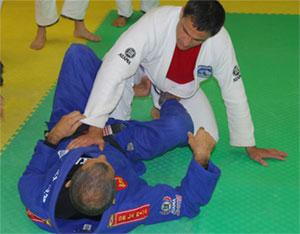Hey Everyone! Yes its that time for the extra blog post so tonight I thought that i would explain what I failed to go in detail about in my 10 minute lesson plan. If you weren't at my presentation, I covered history using the difference in philosophies of different martial arts. Using that, I explained Jiu-Jitsu's creation, effect in modern day, and my mentorship. After that slide I had information about positional control, but it was there where I only had one minute to wrap up my presentation so...tonight for this post I will teach you the positional control that are most essential and even show you a new advanced positional control that I learned last week called the Delajiva Guard.
 |
| (Blue) Standard closed Guard |
My first primary positional control I believe is most important is The Guard. With variations of Rubber-Guard, Spider-Guard and High-Guard this position is very much adaptable to any situation or advantage you've been given. Now this I believe because like I said in my presentation, Jiu-Jitsu's main focus is ground fighting, with that said the most probable spot you will land your body in will be The Guard; on your back with your legs either open, closed around his body or feet planted on your opponent's hips. This is considered a defensive position as your leg's control over his body and hands are your only protection between his full body control and the punches he may throw over you. From here the defender has many options, he may elbow escape through the fish hook technique or if he's daring he may even bypass the risk and go straight into attack from guard which include the dangerous triangle choke from Guard and arm-bar from the Guard. Either route, this technique is most ideal for me, since I have long and flexible legs, this is my main position. I feel in control of my opponents body and is useful for me to stay strong to the philosophy of "not lose".
 |
| (Blue) Standard Mount |
My next Position of interest in The Mount a position of total dominance over an opponent and weakness of the victim. With other sects of the position that include high mount, half-mount and side mount generally every sect displays a prominent dominance over the other. Here the victim is at a loss of control. In a street fight, an attack in mount would relentlessly punch and without any hip or arm control the person under has no defense but his hands to defend his face and exposed body parts. The only way to get out of this is to somehow get out though his knee control by elbow escape and achieve the guard control like stated up top. From here, if the attacker, you are, at this point, BLESSED with dominating options. Armbars, Americanas, Kimuras, Ankle Locks, Chokes, and direct access to punch the face is at hand leading a almost solidified victory. I for one do not like mounting an opponent, i feel uncomfortable as i am lightweight and don't feel i have a solid base to keep my opponent in mounted control. Mount is ideal for heavier practitioners to make this their "go to" position because their weight adds to the force of their attacks and also adds extra resistance to the ability of the mounted to escape.
With both the Guard and mount providing an offensive and defensive background, you can probably find out which one is good and which one is bad. These positions were the first i learned in order to even think about doing anything else and even with my 5 years of knowledge with these basic positions, i haven't mastered them...not even close man...Besides the fact that these are the most basic, i showed you all these tonight because i feel that these two are the base of Jiu-Jitsu the base of positional control and in order to learn what i learned last week, the Delajiva Guard, i needed to have an adept understanding of how to use both positional control to my advantage.

Without Further ado i want to show you the Delajiva Guard, an advanced positional control that i learned last week from my mentor that varies much from two positions, butterfly and combative guard. the idea for the Delajiva guard was rooted in neutrality and power given to the user to flip the fight in their favor. Its a sneaky position, where the users left left hooks under the opponents right leg and then uses their right leg and posts it on the opponent's hip. I tried using it and didn't get an understanding of the move at all. In fact i thought wow this is a stupid move why not just go into regular guard? While this control does require more energy and a more complex position, i found that i guarantees positional control in your favor...whether you lose that given position is up to you but for the moment it will take you where you want to be. From here, i took the leg hook and leg post concept and played around with the idea while standing up and to my surprise, is an actual sweep the my instructor showed me a day later. Over all this is what I've been playing with and is a position i will be using a lot.
Check in again soon as within the next two weeks i will be sparring with another one of my friends who does Jiu-Jitsu as his senior project as well and we will be providing both sides of our roll against each other...Thanks!


